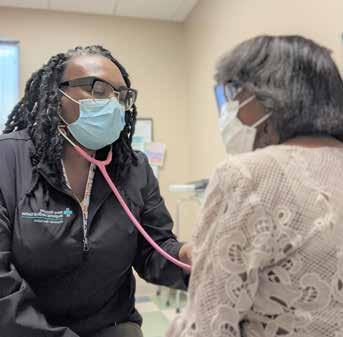
9 minute read
Advocating for Full Practice Autonomy for Nurse Practitioners
BY JAMES Z. DANIELS
There are 24 states in the United States that have freed nurse practitioners from the requirement that they work in collaboration with a supervising physician as they go about the business of providing care to any and all patients. North Carolina, unfortunately, is not one of them. Nurse practitioners believe that these regulations have lost their usefulness and are organized to change it. Their position is that these provisions actually constrain the delivery of effective, efficient, and accessible health care and have huge implications for impacting public health. They are organized and are taking the medical organizations head on through leveraging the persuasive and politically astute nurses elected to the legislature—and there are five of them, as well as the support of the North Carolina Nurses Association and the National Association of Nurse Practitioners.
Many in the physician community, while agreeing that it is critical that health care be available far and wide, have their own reasons for opposing granting full professional autonomy to nurse practitioners. They too have marshalled their ability to remind elected officials of the financial support they received from the medical community that can easily be transferred elsewhere.
It appears that since 2014 this issue has been debated, argued over, and challenged with a dab of acrimony at times in the North Carolina legislature where it now rests. Herein is an account of how this process has achieved a significant level of public awareness that influences the outcome from the perspective of two NPs. It intersects the heightened discussions on health quality, health availability, health access, and health costs to cite some of the dominant themes.
North Carolina law is explicit. NPs and certified nurse midwives are to be supervised by a physician. These health providers are classified as advance practice nurses because of their credentials, training, and experience. State regulations require that these nurses have a standing agreement with a physician and meet with them every six months. A written statement defines the joint practice of a physician and an NP in a collaborative and complementary working relationship. It frequently includes the responsibilities of both the collaborating physician and the NP and often defines the prescriptive authority of an NP. These are the issues that encircle autonomy and are a nationwide phenomenon.
How these provisions are actually made operational is also an issue and adds a dimension to the question of the regulation’s necessity. The states that have liberalized the role of the NP and have seized on the challenge of making health care services more widely available believe there is a quantifiable benefit. Others are bogged down in seeing it as a challenge to physicians’ right to exclusivity in the practice of their training and their craft.
Advanced practice nurses are registered nurses that include nurse practitioners who have received additional training and education to play a more advanced role in the health care system. They may have a master’s degree, post-master’s certificate, or practice-focused Doctor of Nursing Practice degree or even the PhD. With their advanced training, they have the expert knowledge, clinical expertise, and complex decision-making ability necessary for expanded practice and accountability. Advanced practice nurses are capable of handling more complex casework than a registered nurse (RN), and do this with greater autonomy and discretion, and in some areas, are able to practice independently, without the supervision of a physician.
As a result, advanced practice nurses are increasingly relied upon to meet the demand in primary care especially in rural and underserved areas. In New York State, Governor Andrew Cuomo in June of this year, signed into law provisions that no longer require the NP to work under the supervision of a collaborating physician. It requires that practice of care be delivered in accordance with written practice protocols. NPs may enter into a written practice agreement with a collaborating physician if they so choose. It marked the end of a legislative battle that has lasted for a decade.
Schquthia Peacock, FNP, completed her MSN at the University of North Carolina and her internship to satisfy the designation as a FNP in 1999. That year, the private practice clinic where she served filed for bankruptcy. Three of the employees, 2 NPs and a physician decided that they would purchase the business and asked Schquthia to join them. In 2000, it opened under new management as Preston Medical Associates with a new business model in the upscale town of Cary, North Carolina, with a staff of seven diverse employees, comprised of three NPs and a physician. This practice does not face, acutely, the issue of physician oversight and collaboration because access to one is easily attainable to satisfy all the provisions of the (NPR) Nurse Practitioner Regulations.

Schquthia Peacock, FNP
The limited business experience of Schquthia Peacock and her associates necessitated the hiring of a business consultant to ensure that the insurance reimbursement process was operating at the highest level of efficiency guided by established performance metrics. Two issues have stood out for the now seasoned team of providers. They must ensure timely reimbursement from all insurance providers and the timely reporting of their health outcomes experience to comply with the Affordable Care Act because these factors together affect cash flow.
The practice does not advertise its services. They are made known via word of mouth and the rating they receive on the insurance provider sites. They maintain their visibility by having significant presence at community events and sponsor a free annual health clinic that is well attended with patients travelling considerable distances to the site, which is set up tent-style in the clinic’s parking lot. Because of their diversity, they believe they are competitive against other providers in the area. They ensure that their engagement with their patients is culturally appropriate.
The North Carolina Nurses Association supports the legislation to remove the barriers and the constraints on nurse practitioners, and there are several elected representatives who have emphasized that the change does not have much to do with them practicing medicine like doctors. Rather, they have made it plain that for them the issue is driven by their desire to eliminate barriers to health care access because of archaic laws and regulations. The barriers are preventing nurse practitioners from practicing to the full scope of services for which we were educated and trained.
“The facts are,” says Peacock, “we are committed to expanding legislation to sup port the scope of practice and enlarging the health care work force to allow access to care in geographic regions where patients have limited access to quality care.”

Lashonda Wallace, PhD, MSN, FNP, with a patient
Some reports suggest that physicians are less eager to practice in these rural and underserved communities and this is where the NP community can help fill the gap. Forty percent of North Carolina is considered rural. As North Carolina grapples with the expansion of Medicaid, and this is certain to continue, the need for nurse practitioners will remain front and center to serve a rapidly expanding population demanding more health services.
On the Southeastern cost of North Carolina is the city of Wilmington, where there is a nurse practitioner led clinic run entirely by four racially diverse FNPs. The city has a memorable history that evokes both praise and disdain. Towards the end of the 19th century, Wilmington was a majority-black, racially integrated prosperous city, and the largest city in North Carolina. In the Wilmington massacre of 1898, Democrat white supremacists launched a coup that overthrew the legitimately elected local government. They destroyed the property and businesses of black citizens built up since the Civil War, including the only black newspaper in the city, and killed an estimated 60 to more than 300 people. Today the city is one third minority and has become a visitor mecca in the summer because of its beaches.
The test of the rationale to perpetuate physician supervision of nurse practitioners, comes up short when its impact on Lashonda Wallace, PhD, MSN, FNP, is examined. Wallace is highly qualified to function within the prescribed protocols given her credentials. She, however, is bound by the same regulations as a newly minted MSN graduate, in spite of her credentials. Wallace’s clinic is unique in several ways. It is part of a medical service entity—a hospital, yet independent. It serves a very diverse population; it is funded entirely by the Federal government and is constrained by North Carolina’s NP regulations on how care is administered. It delivers care within an OPM (Outpatient Management) system.
“How has the physician oversight requirement impacted your work of getting treatment to patients?” I ask Dr. Wallace.
“Primarily during those times when I needed approval or instruction for a particular case related to care coordination. Additionally, I had some limitations when treating a patient with Hepatitis-C diagnosis in the primary care setting, the HIV patient had restrictions on securing insurance coverage because some carriers demand sign-off only from MDs. Delays of this type impacted life-saving treatment readily available in the family care setting but not accepted by the insurance carrier.”
Wallace describes a very real episode where a patient in a long-term treatment regimen develops an acute condition and needs admission to the hospital. As an NP, she cannot execute this referral because the clinic does not have hospital privileges, and she is not authorized to make this referral even though she is capable of conducting an examination and diagnoses. “Delays of most any type affects continuity of care outcomes,” she says.
The clinic’s NPs get out in the rural communities covering several counties by visiting community centers, conducting health care fairs, and supporting organizations that are focused on improving community health. This gets her and her associates connected to rural and underserved points of influence where they build credibility and community engagement.
This year, as in prior years, the bill now before the legislative committee of the General Assembly of North Carolina awaits a hearing, a necessary step required by law. Perhaps as this process gets underway, the resulting outcome will be one of opposing sides agreeing that lifting the constraining provisions on nurse practitioners is the right thing to do. This would be a good outcome.
James Z. Daniels is a consultant and writer who lives in Durham, North Carolina and frequently contributes to Minority Nurse.





